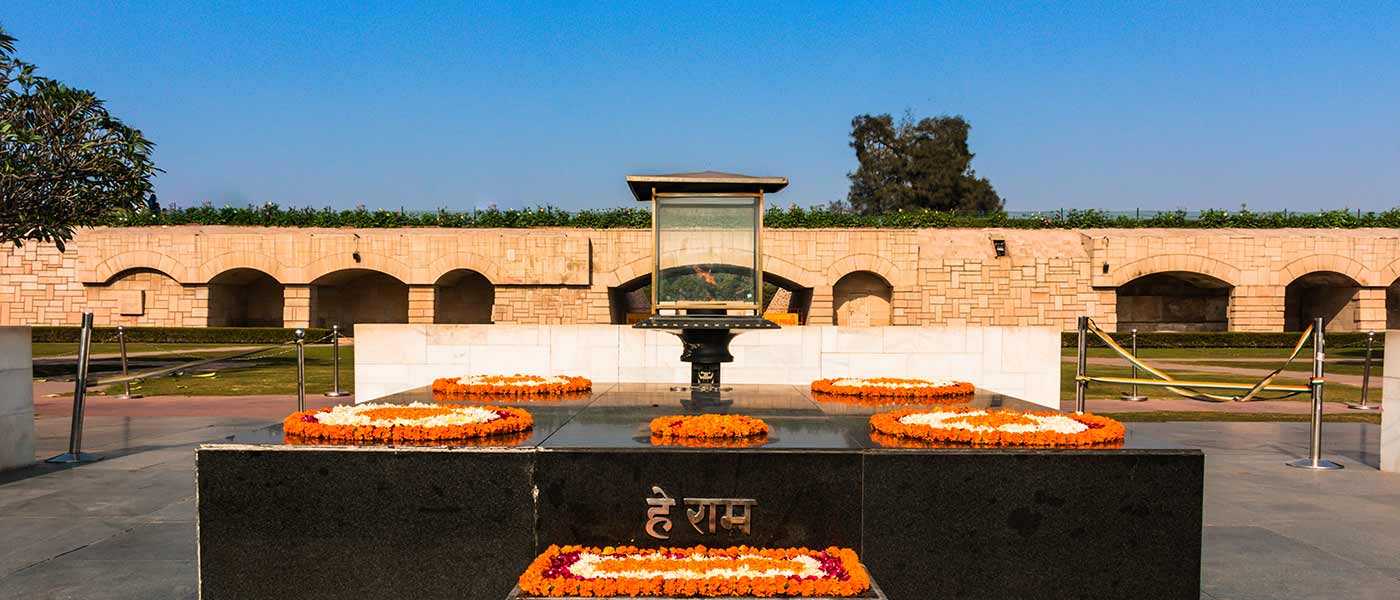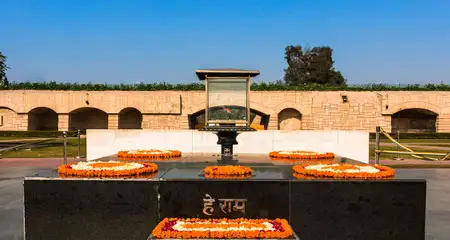Raj Ghat in Delhi is a serene and elegant memorial dedicated to the father of the nation, Mahatma Gandhi. Just like Gandhiji who was a simple yet powerful leader, his memorial also reflects simplicity in its structure and design. Located on the banks of the River Yamuna, Raj Ghat marks the spot where he was cremated after the assassination. In addition to this, the Raj Ghat area also contains the cremation spots aka samadhis of several other famous leaders in the country. Whether you are a history buff or a backpacker, it counts among the prime attractions to explore once you step out of your hotels in Delhi for a sightseeing trip.
Want to know more about this memorial dedicated to Mahatma Gandhi? Here’s everything you need to know about Raj Ghat in Delhi, including its history, timings, architecture, and other facts.
Raj Ghat, Delhi Information: Timing, Entry Fee etc.
| Location | Mahatma Gandhi Marg (Ring Road), New Delhi |
| Type | Memorial or Samadhi |
| Dedicated to | Mahatma Gandhi |
| Timings | 6:30 am to 6:00 pm; every day |
| Entry Fee | Free |
| Camera | Free |
| Architect | Vanu G. Bhuta |
| Material Used | Black Marble |
| Nearest Metro Station | Delhi Gate (Violet Line) |
| Dimensions | 12 x 12 feet square platform with a height of 2 feet |
Raj Ghat, Delhi: History
Mohandas Karamchand Gandhi, also known as Mahatma Gandhi, was assassinated on 30th January 1948 and the following day, his body was cremated at a spot near the Yamuna. Raj Ghat marks the exact location where Gandhiji was consigned to flames and his last rites were performed. A simple memorial was built at this place in keeping with Gandhiji’s philosophy and practice of living a modest life.
Originally, Raj Ghat Gate was the name of an old gate that existed in the walled city of Delhi called Shahjahanabad. It opened on the west bank of the River Yamuna at a place called Raj Ghat. Later, the area where the memorial for Gandhiji was built came to be referred to as Raj Ghat.
Over the years, the samadhis of many notable Indian leaders were constructed in the Raj Ghat area, including former Presidents and Prime Ministers of the country. Rashtriya Smriti Sthal, the samadhi of Atal Bihari Vajpayee constructed in 2018 is the latest addition to the Raj Ghat area.
Raj Ghat, Delhi Architecture
Gandhiji’s memorial at Raj Ghat is a square platform made using black marble. The plain structure has the words ‘Hey Ram’ inscribed on it since these were the last words uttered by the assassinated leader. On top of the marble platform, an eternal flame enclosed in a glass frame burns ceaselessly, all through the day and night. The memorial was designed by Vanu G. Bhuta in keeping with Gandhiji’s policy of simple living and high thinking.
A footpath made of stones will lead you to the memorial, which is housed within a walled enclosure. The stone pathway has lush green lawns on both sides. The landscaping of the memorial was done by Alick Percy-Lancaster, who was the last British national to occupy the position of the Superintendent of Horticultural Operations under the Govt. of India.
There is also a beautiful garden surrounding the memorial. The garden has a number of labeled trees that have been planted by noted dignitaries from around the world, including Queen Elizabeth II, Vietnamese leader Ho Chi Minh, USA President Dwight D. Eisenhower, and several others.
Raj Ghat: Today
Today, Raj Ghat stands as one of the top places to visit in Delhi due to its historical and national significance. The memorial is kept decorated with fresh flowers every day and is visited by both Indian and foreign tourists. Even delegates, dignitaries, and VIPs arriving from other countries make it a point to visit the memorial and pay their respect to the departed soul of Mahatma Gandhi.
Apart from the memorial, Raj Ghat is also the location for a museum dedicated to the memory of the great leader. Every Friday, a prayer meeting is organized at Raj Ghat in remembrance of the father of the nation. Prayer ceremonies are also held on the occasions of Gandhiji’s birth and death anniversaries.
Raj Ghat Museum
The National Gandhi Museum or Gandhi Memorial Museum at Raj Ghat celebrates the life and ideology of Mahatma Gandhi through a collection of pictures, sculptures, books, films, and other memorabilia related to Gandhiji’s life. The museum has a rich collection of more than 35,000 documents and books related to Gandhiji’s life and works, some of which have been written by the leader himself. It also exhibits 23 models of charkhas or spinning wheels along with some of his personal items, such as his dhoti, shawl, walking sticks, a few of his teeth, and even one of the bullets that were used to assassinate him.
There is an audio-visual section at the museum where films on Gandhiji’s life and work are shown inside an auditorium of 75 seats.
- Film Show Timings: 4:00 pm to 5:00 pm; every Saturday and Sunday
- Film Show Fee: Free
Memorials in the Vicinity of Raj Ghat, Delhi
There are a few other memorials of famous Indian leaders and personalities that stand in the vicinity of Raj Ghat. Some of the most important memorials in the area include:
- Vijay Ghat (Lal Bahadur Shastri)
- Shantivan (Pandit Jawahar Lal Nehru)
- Shakti Sthal (Indira Gandhi)
- Veer Bhoomi (Rajiv Gandhi)
- Karma Bhumi (Shankar Dayal Sharma)
- Rashtriya Smriti Sthal (Atal Bihari Vajpayee)
In addition to these, the area also houses the memorials of Devi Lal, Choudhary Charan Singh, Jagjivan Ram, Giani Zail Singh, Chandra Sekhar, and I.K Gujral.
Attractions near Raj Ghat, Delhi
- Red Fort (2.1 km)
- Jama Masjid (2.5 km)
- National Museum of Natural History (3.7 km)
- Agrasen ki Baoli (3.7 km)
- Connaught Place (4.2 km)
- Jantar Mantar (4.4 km)
- Purana Qila (5.1 km)
- India Gate (5.3 km)
- Rashtrapati Bhavan (6.8 km)
Mahatma Gandhi is one of those leaders who spent his entire life to ensure that we live in a free country. When you are in Delhi, don’t forget to pay homage to the great leader. Spend some time at his memorial and soak in the serene vibes of the place.




























